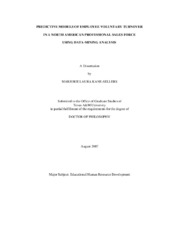| dc.contributor.advisor | Egan, Toby Marshall | |
| dc.creator | Kane-Sellers, Marjorie Laura | |
| dc.date.accessioned | 2010-01-15T00:00:36Z | |
| dc.date.accessioned | 2010-01-16T01:49:59Z | |
| dc.date.available | 2010-01-15T00:00:36Z | |
| dc.date.available | 2010-01-16T01:49:59Z | |
| dc.date.created | 2007-08 | |
| dc.date.issued | 2009-05-15 | |
| dc.identifier.uri | https://hdl.handle.net/1969.1/ETD-TAMU-1486 | |
| dc.description.abstract | With the supply of talented employees for the predicted available jobs around the
world declining, employee retention and voluntary turnover have jumped to the forefront
of HRD practitioners’, as well as senior managers’, strategic initiative. By 2008,
demographers predict that 76 million baby boomers will be eligible for retirement. The
generations that followed these individuals, born between 1946 and 1962, are not
numerically adequate to fill the vacancies that these retirements will create. A growing
concern exists that the expected annual growth in the number of eligible employees will
be outpaced by economic growth predictions. While employee retention and employee
voluntary turnover have received considerable scholarly attention, few research studies
have examined the phenomenon in a professional sales arena. No investigation to date
has tracked employee voluntary turnover and retention over a 14-year longitudinal wave
as was the focus of this study.
This population study examined employee retention of a Fortune 500 North
American industrial automation manufacturer’s professional sales force over a 14-year period. It focused on personal characteristics, work characteristics, and human resource
development (HRD) intervention factors influencing employee voluntary turnover. The
results suggest that training and development participation contributes more significantly
to employee retention than salary and job title promotions to the firm’s ability to retain
sales professionals.
The theoretical underpinnings associated with these findings reinforce the
importance of human capital theory, social identity theory, expectancy theory, and
distributive justice theory. They also suggest that employee retention should be included
in calculations that measure the return on investment for training and development
interventions. Further, these results that emerged from comprehensive data mining
suggest that a structured training and development program embeds aspects of employee
socialization that can influence a professional sales employee’s tenure in the
organization. Formal training can serve to socialize the employee into the organization,
thus, deepening the effect of social capital theory to build normative organizational
commitment, a mediator of employee retention. This effect appeared to be more
significant for non-Caucasian sales professionals who remained in the organization when
included in a structured sales training program. | en |
| dc.format.medium | electronic | en |
| dc.format.mimetype | application/pdf | |
| dc.language.iso | en_US | |
| dc.subject | voluntary turnover | en |
| dc.subject | employee retention | en |
| dc.subject | training & development | en |
| dc.title | Predictive models of employee voluntary turnover in a North American professional sales force using data-mining analysis | en |
| dc.type | Book | en |
| dc.type | Thesis | en |
| thesis.degree.department | Educational Administration and Human Resource Development | en |
| thesis.degree.discipline | Educational Human Resource Development | en |
| thesis.degree.grantor | Texas A&M University | en |
| thesis.degree.name | Doctor of Philosophy | en |
| thesis.degree.level | Doctoral | en |
| dc.contributor.committeeMember | Erlandson, David A. | |
| dc.contributor.committeeMember | Slocum, John W. | |
| dc.contributor.committeeMember | Thompson, Stephen W. | |
| dc.contributor.committeeMember | Tolson, Homer | |
| dc.type.genre | Electronic Dissertation | en |
| dc.type.material | text | en |
| dc.format.digitalOrigin | born digital | en |


